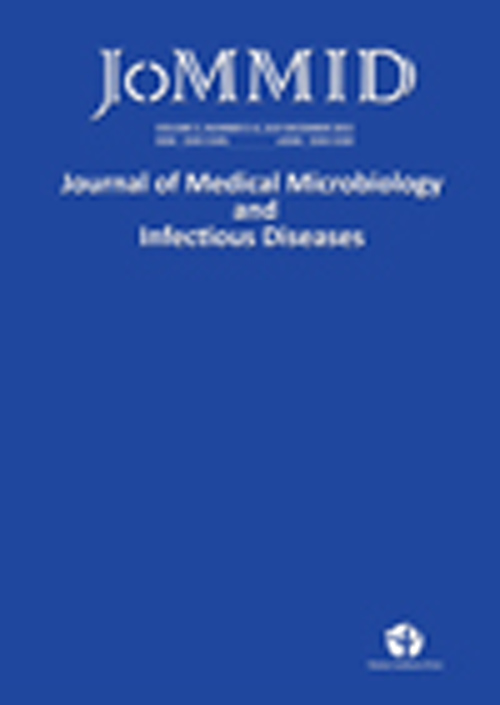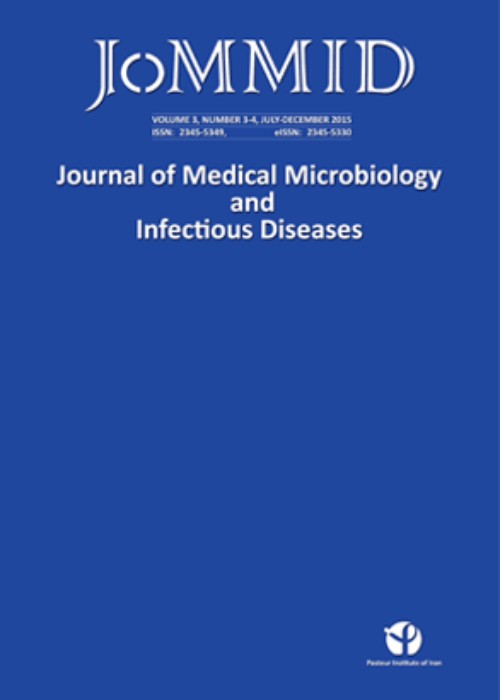فهرست مطالب

Journal of Medical Microbiology and Infectious Diseases
Volume:6 Issue: 2, Spring-Summer 2018
- تاریخ انتشار: 1397/08/12
- تعداد عناوین: 8
-
-
Pages 37-42IntroductionAcinetobacter baumannii is one of the major causes of nosocomial infections. We investigated the distribution of A. baumannii among patients and the environment in special care units of a hospital in Tehran, Iran.MethodsSixty-nine non-duplicate clinical and environmental samples were collected from ICU, Post-ICU, and CCU in EbneSina Hospital (Tehran, Iran) from June 2015 to April 2016. The isolates were identified using standard biochemical tests, and their identity was confirmed by detection of blaoxa51 gene. Susceptibility to 14 antibiotics was determined by disc the diffusion method, and genetic fingerprinting of the isolates was performed by random amplified polymorphic DNA (RAPD-PCR).ResultsWe recovered 66 A. baumannii isolates, 41 from patients, and 25 from the environment. All isolates from patients were resistant to all tested antibiotics except colistin. Environmental isolates were resistant to piperacillin (100%), tetracycline, piperacillin/tazobactam, beta-lactams and quinolones (86%), and amikacin (81%) but sensitive to colistin. The RAPD-PCR results revealed 35 clusters with 80% similarity. Despite the heterogeneity among the RAPD-PCR profiles, similar patterns were observed among 11 clusters comprising both clinical and environmental isolates.ConclusionThe results of this research suggest that the presence of A. baumannii on environmental surfaces could have played an essential role in the colonization of the hospitalized patients.Keywords: Acinetobacter baumannii, RAPD-PCR, MDR, ICU, environmental contamination.
-
Pages 43-47IntroductionChronic Hepatitis B virus infection is a multifactorial disease with a variety of clinical outcomes. Since interferon-gamma (IFN-γ) is a significant immune factor in antiviral defense, this case-control study aimed to investigate the potential relationship between single nucleotide polymorphism of rs2430561 and hepatitis B infection outcome in a population of Birjand city, eastern Iran.MethodsBlood samples were collected from 60 chronically HBV- infected patients and 60 healthy subjects with the history of HBV infection. Genomic DNA was extracted from whole blood by the salting-out method. The first intron of IFN-γ with a length of 264 bp was amplified by Amplification Refractory Mutation System Polymerase Chain Reaction (ARMS-PCR) followed by sequencing.ResultsOur results exhibited a statistically significant difference between patients and control individuals (p-value<0.001). The frequency of the allele A was 73.3% in HBV- infected patients, whereas in controls (individuals with a history of HBV infection) it was 46.7%.ConclusionA statistically significant relationship was found between the IFN-γ (+874T/A, rs2430561) single nucleotide polymorphism (SNP) and chronic HBV infec tion in the studied population. The obtained results showed that HBV infected individuals with T allele have less risk of progressing to chronic HBV infection. It also suggests that the homozygous carriers of the A allele are more vulnerable to chronic HBV infection.Keywords: Chronic Hepatitis B, Single Nucleotide Polymorphism, Interferon-γ (+874T-A), Iran
-
Pages 48-52IntroductionQ fever and brucellosis caused by Coxiella burnetii and Brucella spp., respectively are among the significant zoonotic infectious diseases worldwide affecting both humans and domestic animals. Iran and its neighboring countries in the east are endemic for these diseases. This study, conducted in 2011-2012, aimed to determine the seroprevalence of Q fever and brucellosis among domestic and imported cattle slaughtered in Zabol city of Sistan and Baluchistan province, eastern Iran.MethodsWe collected blood samples from 103 imported and 62 domestic animals. The Sera were separated and examined by an ELISA for the presence of IgG against the two causative agents.ResultsThe seroprevalence of brucellosis in imported cattle was 0.97%, while none of the domestic animals turned positive. Seroprevalence of Q fever in domestic cattle was 3.23%, whereas all imported cattle were negative.ConclusionIn this study, brucellosis and Q fever exhibited a very low seroprevalence in domestic and imported animals. Further studies on other livestock would provide more information on the status of these diseases in the southeast of Iran. Furthermore, studies on the prevalence of these diseases in border regions and neighboring countries of Sistan and Baluchistan would provide more in-depth insights into these diseases and the possibility of their importation to Iran.Keywords: Q Fever, Zoonoses, Coxiella burnetii, Brucella, Iran
-
Pages 53-56IntroductionHydatidosis is an endemic parasitic disease of humans in Iran, and Albendazole (ABZ) is a drug of choice for treatment of this infection. As the Alkaline phosphatase (ALP) is necessary for the metabolism of parasites, this study was aimed to evaluate the effect of ABZ on ALP enzyme activity in hydatid cyst parasite as a marker for drug efficiency.MethodsIn the present study, the ALP activity level was estimated in the extracts of the untreated parasite (Hydatid cyst protoscoleces) as well as the ABZ-treated samples with a final concentration of 100 µg. The protein concentration and the protein bands in the extracted samples were analyzed by Bradford and sodium dodecyl sulfate-polyacrylamide gel electrophoresis (SDS-PAGE) methods, respectively.ResultsThe results showed that the mean value of the ALP activity level of the treated samples (0.474 U/ml/mg) was significantly higher than that of untreated samples (0.205 U/ml/mg) (P<0.05). SDS-PAGE analysis demonstrated the higher intensity of the 59 kDa protein band in ABZ-treated samples, compared to the untreated sample.ConclusionConsidering the effect of the ABZ drug on ALP activity in the hydatid cyst protoscoleces, this enzyme might be regarded as an indicator for the effectivity of drug on this parasite.Keywords: Albendazole, Parasites, Alkaline Phosphatase, Hydatid cyst, Iran
-
Pages 57-61IntroductionRed seaweeds are the source of polyanionic polymers that play a critical role in ionic, mechanical, and osmotic functions of the cells. The Gracilaria polysaccharides have numerous biological activities. This research aimed to compare the in vivo and in vitro effects of the various carbohydrate fractions of the seaweed Gracilariopsis persica.MethodsThe crude polysaccharide of the G. persica seaweed was extracted using three methods, including soaking in water, hot water extraction, and acid extraction. On the optimal conditions, the seaweed polysaccharides were extracted using HCl 0.1 M 10% (w/v), and the crude carbohydrates were precipitated by ethanol. The extract was fractionated on diethylaminoethyl cellulose (DEAE-C) column using a NaCl gradient. The antimicrobial activity of each fraction was assessed by microdilution broth method against 6 bacteria species, including Staphylococcus aureus, Escherichia coli, Methicillin-resistant Staphylococcus aureus (MRSA), Salmonella typhimurium, Pseudomonas aeruginosa, and Aeromonas hydrophila. Moreover, the obtained fractions were orally administered (100 µg/day) for 7 days to 10 groups of 4 adult NMRY mice. The effects of various fractions were evaluated based on the bactericidal effect of the sera and some immune response indicators, including complement activity and humoral immune response against sheep red blood cells (SRBC).ResultsMost of the fractions had direct antibacterial effects; however, oral administration of the fractions neither increased the antibacterial effect of sera nor triggered the complement activity. However, the fractions 1, 2, 5, and 6 significantly induced the humoral immune response against SRBC.ConclusionThe G. persica seaweed has direct antibacterial effects. However, unlike the humoral immune response induction, the carbohydrate fractions have no effects on innate immune responses.Keywords: Gracilaria, Mice, Anti-bacterial Agents, Immunity
-
Pages 62-66IntroductionIntestinal parasitic infections are among the most common diseases worldwide and are significant indicators of the health status of communities, especially in developing countries. This study aims to determine the prevalence of intestinal parasites infection in patients referring to Kashan diagnostic laboratories from July 2015 to August 2018.MethodsThis cross-sectional study was carried out on 6921 patients referring to medical diagnostic laboratories, Kashan, central Iran. Fecal specimens were examined by direct smear and formalin-ether concentration methods. The results together with risk factors including sex, age were recorded and analyzed by descriptive statistics using SPSS 16 software.ResultsOut of the 6921 individuals examined, 3636 (52.5%) were male and 3285 (47.5%) were female. Microscopy revealed the prevalence of parasitic infection by 4.96% (4.96 ± 0.5). Totally 5.1% of males and 4.6% of females had intestinal parasite infections. No significant association was seen between sex, seasons, and parasite infections. Rate of infection to intestinal parasites were Blastocystis spp. (3.06%), Entamoeba coli (0.95%), Giardia intestinalis (0.59%), Iodamoeba butschlii (0.23%), Endolimax nana (0.20%), Entamoeba hartmanni (0.20%), Dientamoeba fragilis (0.14%), Chilomastix mesnili (0.07%), Entamoeba histolytica/Entamoeba dispar (0.05%), Hymenolepis nana (0.01%) was the only intestinal worm that observed in one individual. The results showed that 4.48% of the examined individuals were infected with one parasite, 0.39% with two and 0.08% with 3 or more parasites.ConclusionThe prevalence of intestinal parasites in our study was lower than those from other areas of Iran and other countries, indicating an increase in health status as well as public awareness of infectious diseases.Keywords: Prevalence, Intestinal parasites, Kashan, Iran
-
Pages 67-71IntroductionRabies is a highly fatal disease. However, it is quite preventable. Community awareness about rabies is one of the key components for prevention, which should be assessed and routinely monitored by standard questionnaires. We aimed to develop and validate a Persian knowledge, attitude and practice questionnaire for rabies (PKAP-Rabies) in the general population of Iran.MethodsThe questionnaire was developed based on existing literature and conducting focus group discussions with experts in the field. Content, face, and construct validity were checked by gathering the opinion of 10 experts in the field. Test-retest reliability was assessed by re-administrating the questionnaire to the same individuals after a 15-days interval.ResultsThe questionnaire consisted of 64 items, covering five domains including ‘demographics’ (19 items), knowledge about animal and human rabies (14 and 10 items, respectively), attitude towards rabies prevention in animals (6 items), and practice towards rabies prevention/control (14 items). The questionnaires were mainly filled by young (mean= 28.6, SD= 10.3 years) women (63.3%) with a university-level educational background (36.7%). Most knowledge questions had a proper difficulty level (average difficulty index= 20-80%). Wilcoxon test also showed proper test-retest reliability for this questionnaire (PWilcoxon > 0.05).ConclusionsThe PKAP-Rabies questionnaire appeared to be feasible, valid and reliable for assessing KAP towards rabies in the general population of Iran with potential application in future large-scale surveys. Information from such surveys can provide insight into adopting prevention and control measures, and would allow us to evaluate the impact of current and upcoming interventions.Keywords: Rabies, Knowledge, Attitude, Practice, Iran
-
Pages 72-76IntroductionMultidrug-resistant (MDR) Pseudomonas aeruginosa isolates are among the common cause of Nosocomial infections. In P. aeruginosa infections, several genes, mexA, and mexB are involved in resistance to antibiotics and pslA, pelA and brlR contribute to biofilm formation. This study aims to investigate the prevalence of these genes in P. aeruginosa isolates and to determine their relationship with biofilm formation, antibiotic resistant, pigment production, and source of infection.MethodsWe collected 63 specimens out of 90 samples from patients hospitalized in a hospital affiliated to Shiraz University of Medical Sciences. The specimens belonged to 42 men and 21 women and included urine, sputum, wound, skin, blood, body fluid, and central venous blood (CVB). The samples were cultured on solid media and diagnosed according to standard phenotypic characteristics. Disk diffusion method was used to identify the clinical MDR P. aeruginosa isolates, and the genes pslA, pelA, brlR, mexA, and men were detected by PCR detected.Resultsabout 25.4% of the clinical isolates were MDR, i.e., resistant to three or more antibiotics. The prevalence of the genes in the clinical isolates was as follows: pslA (92.1%), pelA (68.3%), brlR (93.7%), mexA (95.2%) and mexB (50.8%). The highest and lowest prevalence of drug resistance belonged to ceftriaxone and amikacin, respectively. The highest MDR P. aeruginosa isolates originated from wound, urine and sputum specimens.ConclusionThe presence of MDR isolates correlated significantly with the patients’ gender, the origin of specimens, and bacterial pigment production. In this study, the detected genes did not significantly correlate with the MDR features of the isolates. J Med Microbiol Infec Dis, 2018, 6 (2): 5 pages.Keywords: Pseudomonas aeruginosa, Multidrug resistance, Biofilm genes, Shiraz, Iran


